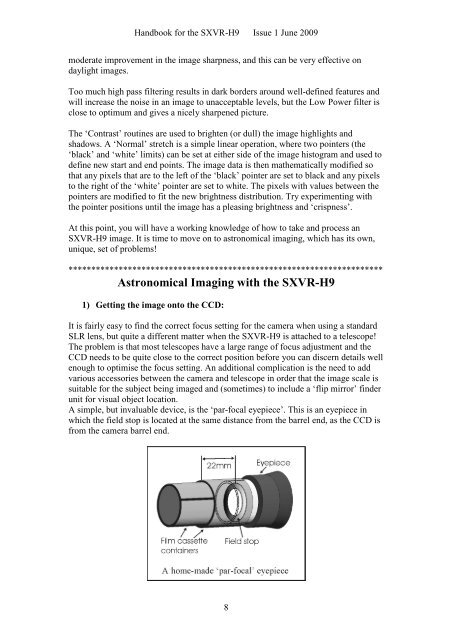SXVR-H9 handbook.pdf - Starlight Xpress
SXVR-H9 handbook.pdf - Starlight Xpress
SXVR-H9 handbook.pdf - Starlight Xpress
You also want an ePaper? Increase the reach of your titles
YUMPU automatically turns print PDFs into web optimized ePapers that Google loves.
Handbook for the <strong>SXVR</strong>-<strong>H9</strong> Issue 1 June 2009<br />
moderate improvement in the image sharpness, and this can be very effective on<br />
daylight images.<br />
Too much high pass filtering results in dark borders around well-defined features and<br />
will increase the noise in an image to unacceptable levels, but the Low Power filter is<br />
close to optimum and gives a nicely sharpened picture.<br />
The ‘Contrast’ routines are used to brighten (or dull) the image highlights and<br />
shadows. A ‘Normal’ stretch is a simple linear operation, where two pointers (the<br />
‘black’ and ‘white’ limits) can be set at either side of the image histogram and used to<br />
define new start and end points. The image data is then mathematically modified so<br />
that any pixels that are to the left of the ‘black’ pointer are set to black and any pixels<br />
to the right of the ‘white’ pointer are set to white. The pixels with values between the<br />
pointers are modified to fit the new brightness distribution. Try experimenting with<br />
the pointer positions until the image has a pleasing brightness and ‘crispness’.<br />
At this point, you will have a working knowledge of how to take and process an<br />
<strong>SXVR</strong>-<strong>H9</strong> image. It is time to move on to astronomical imaging, which has its own,<br />
unique, set of problems!<br />
*********************************************************************<br />
Astronomical Imaging with the <strong>SXVR</strong>-<strong>H9</strong><br />
1) Getting the image onto the CCD:<br />
It is fairly easy to find the correct focus setting for the camera when using a standard<br />
SLR lens, but quite a different matter when the <strong>SXVR</strong>-<strong>H9</strong> is attached to a telescope!<br />
The problem is that most telescopes have a large range of focus adjustment and the<br />
CCD needs to be quite close to the correct position before you can discern details well<br />
enough to optimise the focus setting. An additional complication is the need to add<br />
various accessories between the camera and telescope in order that the image scale is<br />
suitable for the subject being imaged and (sometimes) to include a ‘flip mirror’ finder<br />
unit for visual object location.<br />
A simple, but invaluable device, is the ‘par-focal eyepiece’. This is an eyepiece in<br />
which the field stop is located at the same distance from the barrel end, as the CCD is<br />
from the camera barrel end.<br />
8

















